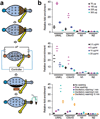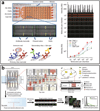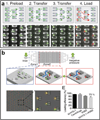Recent Progress of Microfluidics in Translational Applications
- PMID: 27091777
- PMCID: PMC4922259
- DOI: 10.1002/adhm.201600009
Recent Progress of Microfluidics in Translational Applications
Abstract
Microfluidics, featuring microfabricated structures, is a technology for manipulating fluids at the micrometer scale. The small dimension and flexibility of microfluidic systems are ideal for mimicking molecular and cellular microenvironment, and show great potential in translational research and development. Here, the recent progress of microfluidics in biological and biomedical applications, including molecular analysis, cellular analysis, and chip-based material delivery and biomimetic design is presented. The potential future developments in the translational microfluidics field are also discussed.
Keywords: cellular analysis; chip-based material delivery; microfluidics; molecular analysis; organ-on-a-chip.
© 2016 WILEY-VCH Verlag GmbH & Co. KGaA, Weinheim.
Figures













Similar articles
-
High-throughput screening approaches and combinatorial development of biomaterials using microfluidics.Acta Biomater. 2016 Apr 1;34:1-20. doi: 10.1016/j.actbio.2015.09.009. Epub 2015 Sep 8. Acta Biomater. 2016. PMID: 26361719 Review.
-
Bio-microfluidics: biomaterials and biomimetic designs.Adv Mater. 2010 Jan 12;22(2):249-60. doi: 10.1002/adma.200900821. Adv Mater. 2010. PMID: 20217686
-
Applications of Microfluidics and Organ-on-a-Chip in Cancer Research.Biosensors (Basel). 2022 Jun 27;12(7):459. doi: 10.3390/bios12070459. Biosensors (Basel). 2022. PMID: 35884262 Free PMC article. Review.
-
Microengineering in cardiovascular research: new developments and translational applications.Cardiovasc Res. 2015 Apr 1;106(1):9-18. doi: 10.1093/cvr/cvv049. Epub 2015 Feb 17. Cardiovasc Res. 2015. PMID: 25691539 Free PMC article. Review.
-
Microfluidic Platforms toward Rational Material Fabrication for Biomedical Applications.Small. 2020 Mar;16(9):e1903798. doi: 10.1002/smll.201903798. Epub 2019 Oct 25. Small. 2020. PMID: 31650698 Review.
Cited by
-
PRADA: Portable Reusable Accurate Diagnostics with nanostar Antennas for multiplexed biomarker screening.Bioeng Transl Med. 2020 May 15;5(3):e10165. doi: 10.1002/btm2.10165. eCollection 2020 Sep. Bioeng Transl Med. 2020. PMID: 33005736 Free PMC article.
-
Recent Progress in Microfluidic Models of the Blood-Brain Barrier.Micromachines (Basel). 2019 Jun 5;10(6):375. doi: 10.3390/mi10060375. Micromachines (Basel). 2019. PMID: 31195652 Free PMC article. Review.
-
Invertebrate Retinal Progenitors as Regenerative Models in a Microfluidic System.Cells. 2019 Oct 22;8(10):1301. doi: 10.3390/cells8101301. Cells. 2019. PMID: 31652654 Free PMC article.
-
In vitro high-content tissue models to address precision medicine challenges.Mol Aspects Med. 2023 Jun;91:101108. doi: 10.1016/j.mam.2022.101108. Epub 2022 Aug 17. Mol Aspects Med. 2023. PMID: 35987701 Free PMC article. Review.
-
Optical Etching to Pattern Microstructures on Plastics by Vacuum Ultraviolet Light.Materials (Basel). 2020 May 11;13(9):2206. doi: 10.3390/ma13092206. Materials (Basel). 2020. PMID: 32403429 Free PMC article.
References
Publication types
MeSH terms
Grants and funding
LinkOut - more resources
Full Text Sources
Other Literature Sources

